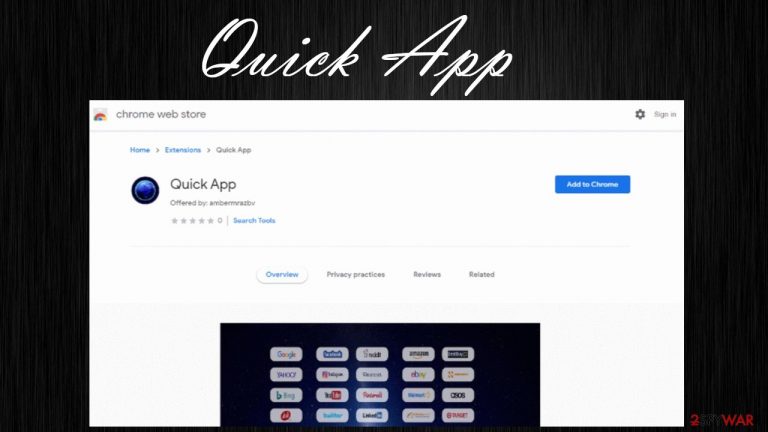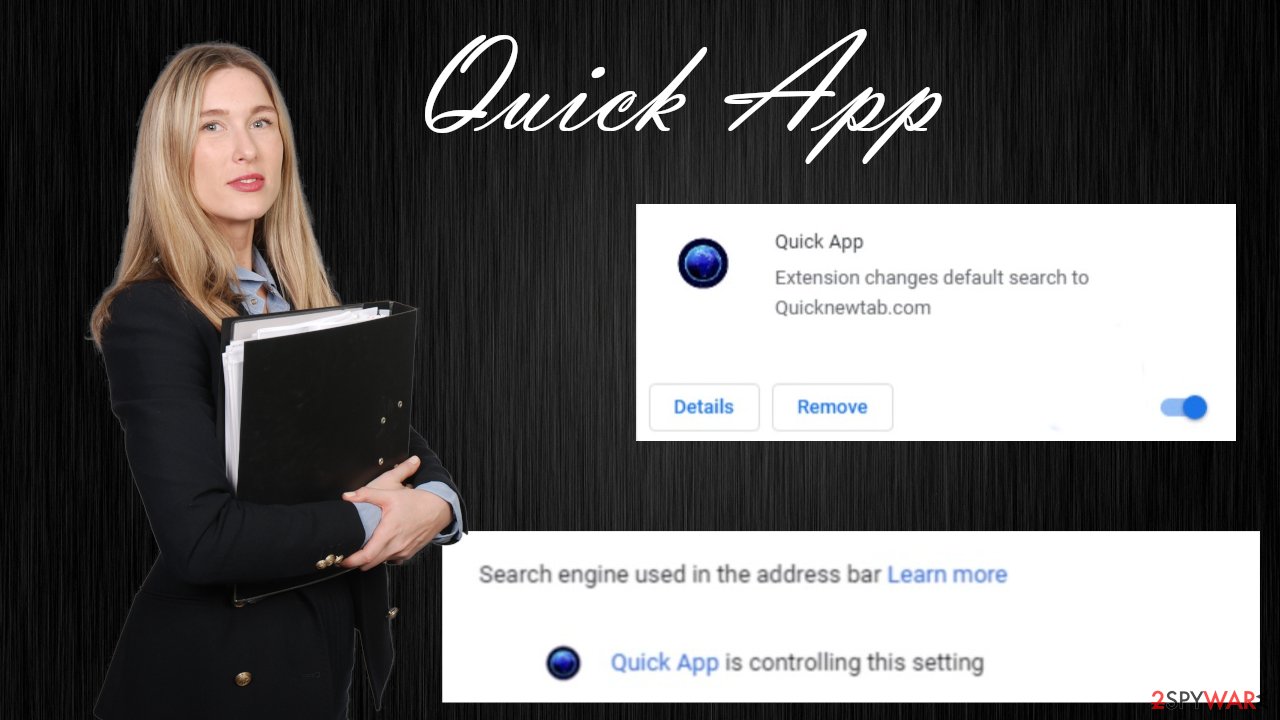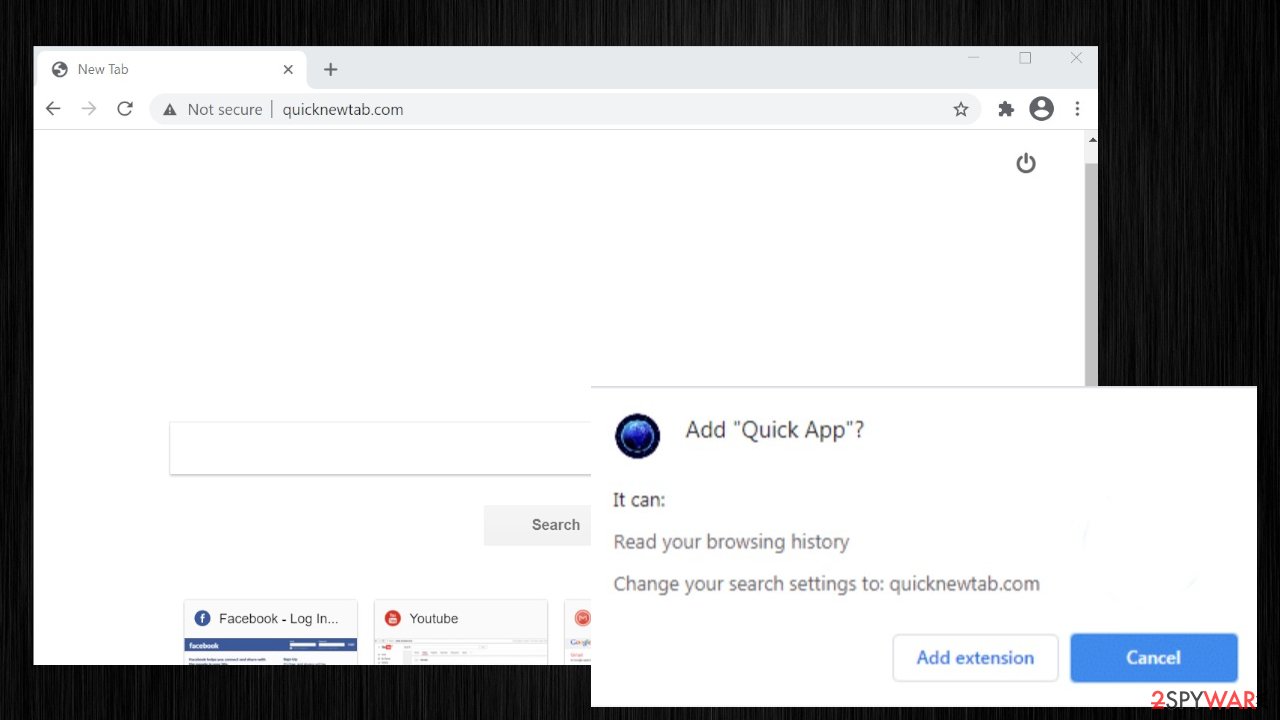Quick App (Virus Removal Guide) - Free Instructions
Quick App Removal Guide
What is Quick App?
Quick App – a browser hijacker redirecting your search inquiries through quicknewtab.com

Quick App is a potentially unwanted program that redirects all search queries through a fake search engine that's appointed without your direct consent. Consequently, your default browser's new tab and homepage are also changed to the same address.
Quicknewtab.com is an address of a fake search engine as it doesn't generate any search results itself. Instead, it redirects users who have installed this browser hijacker to legitimate search engines like Yahoo, Google, etc., but with slight alterations – ads.
They could be shown either as recommended searches or search results. Furthermore, such PUPs are capable of collecting non-personal (in some cases, personal) information. Thus you should remove Quick App with our free guidelines posted at the bottom of this article.
| name | Quick App |
|---|---|
| Type | Browser hijacker, PUP, redirect virus |
| Altered browser settings | Default search engine, new tab, homepage |
| Promoted fake search site | Quicknewtab.com |
| Redirects search through | Bing.com |
| IP address | 104.21.40.106 |
| Symptoms | Search results are riddled with ads and are shown from a different source than before, the device runs slower, decreased browsing speed |
| Risks | Privacy issues, other PUP or malware infections, identity theft, monetary losses |
| Distribution | Official websites, freeware, fake Flash Player updates, deceptive ads |
| Elimination | You must scan your device with a trustworthy anti-malware engine to remove any unwelcomed guests. Then use our removal guides posted below to delete the browser hijackers extension from your browser |
| System repair | All infections leave their traces on your device that could cause the exhibition of various abnormal device behavior. Restore all damage your system has endured by running system diagnostics with the time-proven FortectIntego tool |
Browser hijackers, unnecessary toolbars, adware, and other potentially unwanted programs (PUPs) are rarely installed voluntarily. Such software is usually installed unknowingly through software bundling,[1] deceptive ads, fake Flash Player updates, and other sneaky techniques.
Quick App browser hijacker can be installed either as an app or a browser extension. For a limited time, it was available on Google Chrome Web Store. That doesn't mean that it can affect only the Chrome browser. Others, like Safari, Firefox, Edge, could also be affected.
Usually, such PUPs are falsely advertised as useful tools that would improve your browsing speed, privacy, security, etc. When in fact, they do the exact opposite by slowing down your device and the internet connection and endangering both you and your device. They do that by:
- displaying deceptive ads,
- causing sudden redirects to affiliated websites,
- collecting various device and browser-related details.
Ads and redirects are usually for untrustworthy sites that don't care how they get internet traffic as far as they do. Thus portals that use PUPs for advertisement are usually gambling, scams, porn, malware, PUPs, push notification viruses, and other dangerous content.

It doesn't matter if you've installed Quick App extension willingly or not. It's important to remove it immediately. First, scan your device in question with reliable anti-malware software. If you don't own one, we recommend downloading free security tools such as SpyHunter 5Combo Cleaner or Malwarebytes.
Afterward, feel free to use our comprehensive removal guides displayed at the bottom of this article to delete the browser hijackers extension. And lastly, perform a system tune-up with powerful system optimizing software like the FortectIntego app to ensure your device runs smoothly.
Cyber threats can be avoided by enhancing your cybersecurity
Cybercriminals are created more sophisticated threats and research new, more effective ways to distribute them each day. Such malware as Trojans, ransomware, and similar, can cause a major headache and have terrible outcomes. That's why you should take your care cybersecurity level.
Security experts at DieViren.de[2] have compiled a set of guidelines that won't make your device impenetrable by malware but raise the bar real high. Consider sticking to these suggestions, and you might evade becoming a cyber victim:
- Get the latest updates to your Operating System and other install software as soon as they're available.
- Store backups of all essential data on two separate devices/locations, e.g., cloud, USB drive, offline storage device.
- Acquire a professional security tool and update its virus signatures daily.
- Use a system diagnostics tool to maintain system files and settings.
- Do a web search on the most popular methods hackers use to infect computers to be aware of them.

Swifty methods to remove Quick App virus if installed as an app or a browser extension
Changed default search engine on your browser, search results riddled with questionable ads, sudden redirects to untrustworthy pages are the main symptoms of Quick App virus. Whether you fell for the false advertisement campaign or have no idea how this browser hijacker got on your device, you have to remove it.
The best way to do it is by performing a full system scan with a dependable AV tool. You should constantly update such software so it could prevent you from visiting dangerous websites and block cyber threats at your doorstep. If the PUP was installed as a browser extension, please use our Chrome, Firefox, and other guides to remove it.
Finally, you should consider using time-proven system repair tools to fix any system irregularities. Messy Registry and other modifications done by infections to core system settings could result in freezing, BSoDs,[3] lag, and other abnormal device behavior.
You may remove virus damage with a help of FortectIntego. SpyHunter 5Combo Cleaner and Malwarebytes are recommended to detect potentially unwanted programs and viruses with all their files and registry entries that are related to them.
Getting rid of Quick App. Follow these steps
Uninstall from Windows
Instructions for Windows 10/8 machines:
- Enter Control Panel into Windows search box and hit Enter or click on the search result.
- Under Programs, select Uninstall a program.

- From the list, find the entry of the suspicious program.
- Right-click on the application and select Uninstall.
- If User Account Control shows up, click Yes.
- Wait till uninstallation process is complete and click OK.

If you are Windows 7/XP user, proceed with the following instructions:
- Click on Windows Start > Control Panel located on the right pane (if you are Windows XP user, click on Add/Remove Programs).
- In Control Panel, select Programs > Uninstall a program.

- Pick the unwanted application by clicking on it once.
- At the top, click Uninstall/Change.
- In the confirmation prompt, pick Yes.
- Click OK once the removal process is finished.
Delete from macOS
Remove items from Applications folder:
- From the menu bar, select Go > Applications.
- In the Applications folder, look for all related entries.
- Click on the app and drag it to Trash (or right-click and pick Move to Trash)

To fully remove an unwanted app, you need to access Application Support, LaunchAgents, and LaunchDaemons folders and delete relevant files:
- Select Go > Go to Folder.
- Enter /Library/Application Support and click Go or press Enter.
- In the Application Support folder, look for any dubious entries and then delete them.
- Now enter /Library/LaunchAgents and /Library/LaunchDaemons folders the same way and terminate all the related .plist files.

Remove from Microsoft Edge
Delete unwanted extensions from MS Edge:
- Select Menu (three horizontal dots at the top-right of the browser window) and pick Extensions.
- From the list, pick the extension and click on the Gear icon.
- Click on Uninstall at the bottom.

Clear cookies and other browser data:
- Click on the Menu (three horizontal dots at the top-right of the browser window) and select Privacy & security.
- Under Clear browsing data, pick Choose what to clear.
- Select everything (apart from passwords, although you might want to include Media licenses as well, if applicable) and click on Clear.

Restore new tab and homepage settings:
- Click the menu icon and choose Settings.
- Then find On startup section.
- Click Disable if you found any suspicious domain.
Reset MS Edge if the above steps did not work:
- Press on Ctrl + Shift + Esc to open Task Manager.
- Click on More details arrow at the bottom of the window.
- Select Details tab.
- Now scroll down and locate every entry with Microsoft Edge name in it. Right-click on each of them and select End Task to stop MS Edge from running.

If this solution failed to help you, you need to use an advanced Edge reset method. Note that you need to backup your data before proceeding.
- Find the following folder on your computer: C:\\Users\\%username%\\AppData\\Local\\Packages\\Microsoft.MicrosoftEdge_8wekyb3d8bbwe.
- Press Ctrl + A on your keyboard to select all folders.
- Right-click on them and pick Delete

- Now right-click on the Start button and pick Windows PowerShell (Admin).
- When the new window opens, copy and paste the following command, and then press Enter:
Get-AppXPackage -AllUsers -Name Microsoft.MicrosoftEdge | Foreach {Add-AppxPackage -DisableDevelopmentMode -Register “$($_.InstallLocation)\\AppXManifest.xml” -Verbose

Instructions for Chromium-based Edge
Delete extensions from MS Edge (Chromium):
- Open Edge and click select Settings > Extensions.
- Delete unwanted extensions by clicking Remove.

Clear cache and site data:
- Click on Menu and go to Settings.
- Select Privacy, search and services.
- Under Clear browsing data, pick Choose what to clear.
- Under Time range, pick All time.
- Select Clear now.

Reset Chromium-based MS Edge:
- Click on Menu and select Settings.
- On the left side, pick Reset settings.
- Select Restore settings to their default values.
- Confirm with Reset.

Remove from Mozilla Firefox (FF)
Remove dangerous extensions:
- Open Mozilla Firefox browser and click on the Menu (three horizontal lines at the top-right of the window).
- Select Add-ons.
- In here, select unwanted plugin and click Remove.

Reset the homepage:
- Click three horizontal lines at the top right corner to open the menu.
- Choose Options.
- Under Home options, enter your preferred site that will open every time you newly open the Mozilla Firefox.
Clear cookies and site data:
- Click Menu and pick Settings.
- Go to Privacy & Security section.
- Scroll down to locate Cookies and Site Data.
- Click on Clear Data…
- Select Cookies and Site Data, as well as Cached Web Content and press Clear.

Reset Mozilla Firefox
If clearing the browser as explained above did not help, reset Mozilla Firefox:
- Open Mozilla Firefox browser and click the Menu.
- Go to Help and then choose Troubleshooting Information.

- Under Give Firefox a tune up section, click on Refresh Firefox…
- Once the pop-up shows up, confirm the action by pressing on Refresh Firefox.

Remove from Google Chrome
Delete malicious extensions from Google Chrome:
- Open Google Chrome, click on the Menu (three vertical dots at the top-right corner) and select More tools > Extensions.
- In the newly opened window, you will see all the installed extensions. Uninstall all the suspicious plugins that might be related to the unwanted program by clicking Remove.

Clear cache and web data from Chrome:
- Click on Menu and pick Settings.
- Under Privacy and security, select Clear browsing data.
- Select Browsing history, Cookies and other site data, as well as Cached images and files.
- Click Clear data.

Change your homepage:
- Click menu and choose Settings.
- Look for a suspicious site in the On startup section.
- Click on Open a specific or set of pages and click on three dots to find the Remove option.
Reset Google Chrome:
If the previous methods did not help you, reset Google Chrome to eliminate all the unwanted components:
- Click on Menu and select Settings.
- In the Settings, scroll down and click Advanced.
- Scroll down and locate Reset and clean up section.
- Now click Restore settings to their original defaults.
- Confirm with Reset settings.

Delete from Safari
Remove unwanted extensions from Safari:
- Click Safari > Preferences…
- In the new window, pick Extensions.
- Select the unwanted extension and select Uninstall.

Clear cookies and other website data from Safari:
- Click Safari > Clear History…
- From the drop-down menu under Clear, pick all history.
- Confirm with Clear History.

Reset Safari if the above-mentioned steps did not help you:
- Click Safari > Preferences…
- Go to Advanced tab.
- Tick the Show Develop menu in menu bar.
- From the menu bar, click Develop, and then select Empty Caches.

After uninstalling this potentially unwanted program (PUP) and fixing each of your web browsers, we recommend you to scan your PC system with a reputable anti-spyware. This will help you to get rid of Quick App registry traces and will also identify related parasites or possible malware infections on your computer. For that you can use our top-rated malware remover: FortectIntego, SpyHunter 5Combo Cleaner or Malwarebytes.
How to prevent from getting browser hijacker
Do not let government spy on you
The government has many issues in regards to tracking users' data and spying on citizens, so you should take this into consideration and learn more about shady information gathering practices. Avoid any unwanted government tracking or spying by going totally anonymous on the internet.
You can choose a different location when you go online and access any material you want without particular content restrictions. You can easily enjoy internet connection without any risks of being hacked by using Private Internet Access VPN.
Control the information that can be accessed by government any other unwanted party and surf online without being spied on. Even if you are not involved in illegal activities or trust your selection of services, platforms, be suspicious for your own security and take precautionary measures by using the VPN service.
Backup files for the later use, in case of the malware attack
Computer users can suffer from data losses due to cyber infections or their own faulty doings. Ransomware can encrypt and hold files hostage, while unforeseen power cuts might cause a loss of important documents. If you have proper up-to-date backups, you can easily recover after such an incident and get back to work. It is also equally important to update backups on a regular basis so that the newest information remains intact – you can set this process to be performed automatically.
When you have the previous version of every important document or project you can avoid frustration and breakdowns. It comes in handy when malware strikes out of nowhere. Use Data Recovery Pro for the data restoration process.
